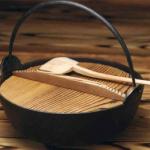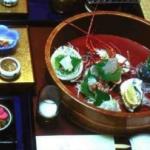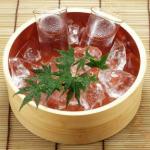Japanese Cooking Utensils and Serving Dishes
In a perfect world, every home kitchen would be equipped with the finest tools and the most elegant dishware. However, preparing and serving Japanese food in your own kitchen doesn't necessarily require any expensive or esoteric utensils. The basic cookware native to the average kitchen is quite adequate for preparing most Japanese dishes. But there are special gizmos and gadgets, pots, pans and paraphernalia that do make certain tasks unique to the preparation of Japanese cuisine considerably easier, and definitely produce more professional results.
Knives - In the preparation of any type of cuisine, a quality set of knives is essential. And although Japanese knives are impressive and would lend a more authentic air to the experience of preparing a Japanese dinner, a good sharp set of domestic knives will work just as well. But keep the serrated ones in the drawer. Few if any Japanese techniques or dishes require them, and the ragged edge of a serrated blade can shred delicate seaweed wrappers.
A basic set of knives, whether Japanese or domestic, should include a large chef's knife, a smaller utility knife, a slender boning knife, a paring knife, and a cleaver. And of course, for the best results, all knives should be kept sparkling clean and razor sharp.
Pots and Pans - When compared to its sleek European counterparts, traditional Japanese cookware tends to be somewhat utilitarian. Much of it is good old-fashioned cast iron, unpretentious and indestructible. But for preparing Japanese food in your own kitchen, your garden-variety non-stick cookware will work just as well for boiling, sautéing, steaming, frying, and poaching.
The preparation of a multi-course Japanese meal may require that several dishes be cooking at once. So a basic set of cookware, whether Japanese or domestic, should include a large kettle with a tight-fitting lid, several saucepans in various sizes, a large skillet, an omelet or sauté pan, a steamer basket, and a set of non-stick baking sheets
Other Useful Cookware
In addition to your basic pots and pans, there are many other items that will facilitate your foray into the world Japanese cuisine. These items include:
A large wok for frying
Several cutting boards in various sizes
Measuring cups and spoons for precision portions
A large colander for rinsing and draining
A fine sieve for straining
A wire rack for draining
A pair of tongs or long chopsticks for transferring food from pan to plate
A slotted spoon for separating foods from liquids
A basting brush for coating foods with sauces and marinades
A fine grater for preparing condiments and garnishes
A bamboo mat for rolling makizushi
A mortar and pestle for grinding seeds and spices
An ice pick for piercing small holes in various ingredients
There are also several modern electrical conveniences that are not essential but would certainly lend themselves to the preparation of Japanese cuisine, including an automatic rice cooker, a crock pot, a hot plate, an electric grill, and an electric deep fat fryer.
Serving Dishes
Japanese dishware, lacquerware and porcelain are among the finest in the world. But you needn't go to great lengths or extravagant expense to provide an elegant presentation for your own rendition of Japanese cuisine. The Zen philosophy of appreciating and utilizing whatever is at hand is the perfect attitude for serving up your culinary creations. The more rustic, the better.
Almost all Asian grocery stores carry a selection of basic plates and bowls at modest prices. Thrift shops are another good source for finding the odd Japanese dish. And if you're so inclined, you can make your own set of Japanese dishes in pottery class.
Whatever your source, to present a traditional Japanese meal for four, you will need:
At least a dozen small, shallow dishes for condiments, dipping sauces, and appetizers
At least eight 5" half-spherical lacquer bowls for serving white rice and miso soup
Four receiving dishes for holding individual portions from shared plates
Four tea mugs without handles
Four pairs of chopsticks
Several large serving trays
Remember that the presentation of Japanese cuisine is just as important as its preparation, and therefore, the aesthetics of your serving dishes will significantly influence the overall effect of your Japanese meal. When choosing your serving dishes, think plain, simple, elegant. Avoid bold, busy patterns, and dishes that are too large or too small for their contents.
Try to coordinate the colors of the dishes with the colors of the food, and keep in mind that many items such as baskets and colorful or interestingly textured leaves, husks, and skins that would normally be discarded might make an elegant garnish that will pull the whole dish together.
 ThingsAsian
ThingsAsian


















